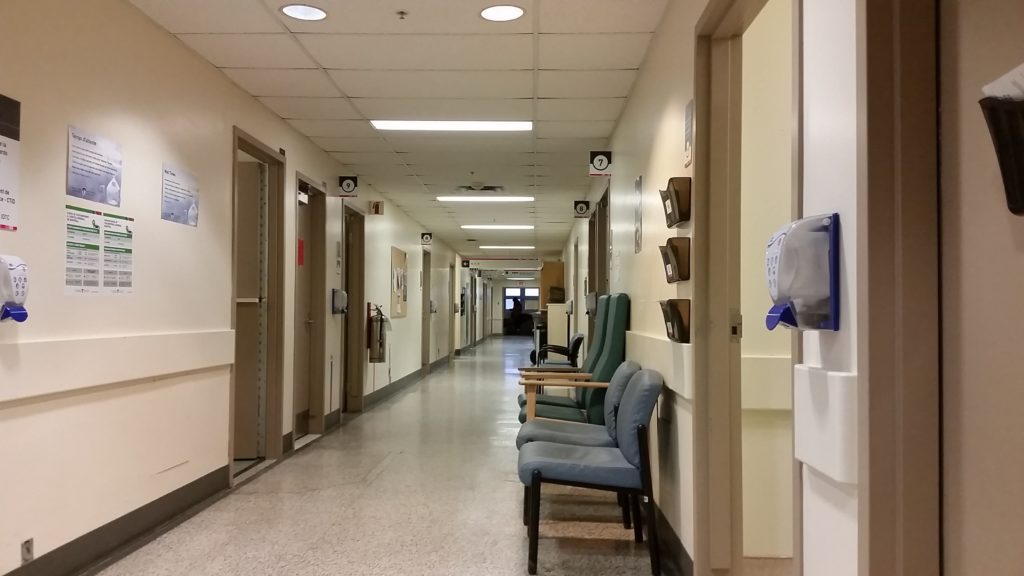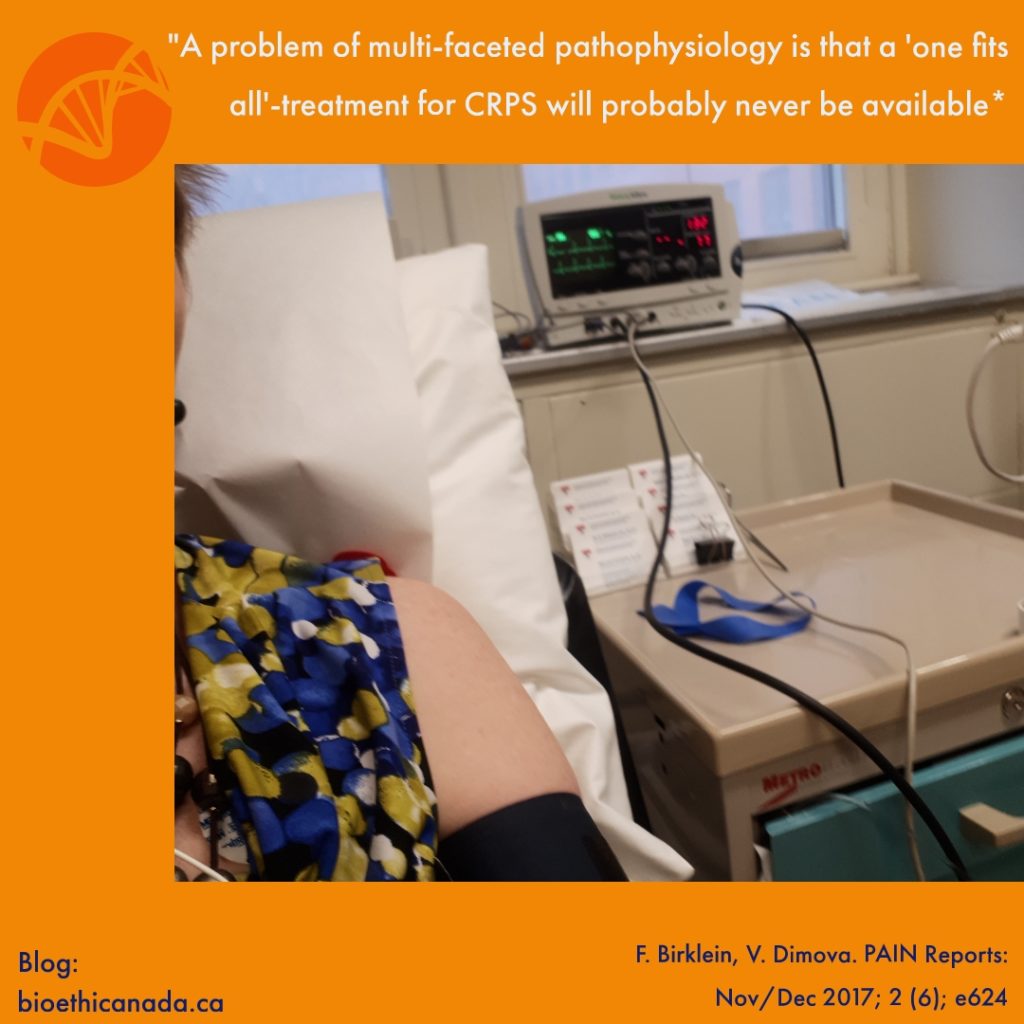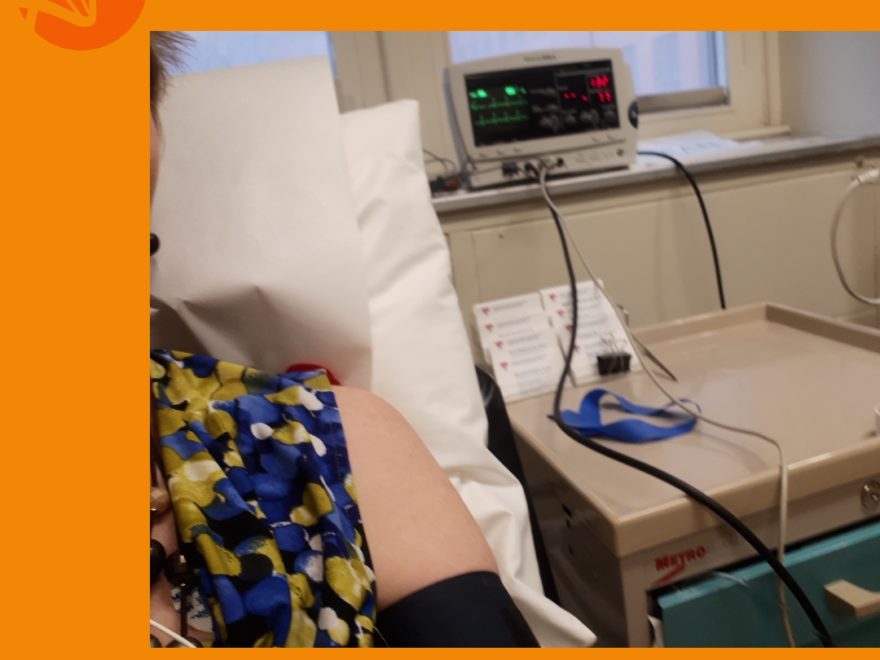This afternoon I had the chance to meet with a group of bright young medical students, from McGill University. To talk with them, and – more importantly! – to answer their questions. About my patient journey. From biomedical ethics (bioethics) professional, to being a patient living with an invisible and chronic pain illness.
From working in healthcare, hospital, and research, to ‘being in the hospital’. From helping others, to needing help. And also to talk about my disease; one that’s difficult to treat, not well understood, painful, and considered rare. There’s even confusion about its name!
It used to be called Reflex Sympathetic Dystrophy (RSD), but its name is now Complex Regional Pain Syndrome (CRPS). But many of the physicians I’ve met still call it RSD.
Before going any further, I want to say a truly heartfelt “Thank you” to Dr. Shir, the Director of the Alan Edwards Pain Management Unit(1). Called the AEPMU, for short. He invited me to meet with these second-year medical students, with him. To co-lead this educational session, as a patient of the AEPMU.
Dr. Shir was at the Canadian Pain Society’s annual conference last year, which I attended as a “Patient Partner”. We chatted a few times during the conference, so he knows that I’ve been trying to raise awareness of CRPS since 2016. That I do some patient advocacy activities, when I can. So, of course, I said “Yes” as soon as Dr. Shir asked if I’d be interested in speaking with these students today.
I don’t know whether the AEPMU offers this opportunity to all of its patients who – like me! – enjoy feeling that they’re helping others. Their multidisciplinary team includes psychologists, so this might be a psychological tool; to help patients, by providing an opportunity to feel as though they’re ‘giving back’ to the AEMPU.
Whatever the underlying rationale, it’s nice to think that someday one of these future doctors might have a patient with CRPS, and be able to diagnose and treat them quickly – because of something they learned during our session today. Or that they might choose to specialize in pain medicine, or in pain research, because of something that struck them in our conversation.
As a bit of background, the AEPMU is a multidisciplinary chronic pain clinic. It’s housed inside the Montreal General Hospital. This teaching hospital is part of the McGill University Health Centre (MUHC). The MUHC also includes other hospitals, along with many treatment centres and research institutes.

That means that these medical students are part of a very large university health network, and have the chance to visit many different clinics and treatment centres as part of their training.
This session was part of their day-long visit to the AEPMU and its related research unit. During our meeting, each of the medical students could ask me questions, as a patient at the AEPMU. Dr. Shir provided additional information to them, on the medical side.
Dr. Shir had explained to me, in advance, how this educational event would be set up. When he brought me into the conference room, the students were already seated in a large U shape of chairs. He and I sat at the 2 chairs that had been placed at the front of the room, and we got started right away.
Instead of a presentation-style event, it was the students who ran the session. They each got to ask me a question, as though they were already doctors and were meeting a new chronic pain patient for the first time. Sometimes one of their questions would build on something about which another student had asked.
Some of the questions seemed more personal, to the student speaking. Dr. Shir added comments to my replies, about things a physician should consider – or ask about – when meeting or evaluating a patient with chronic pain.
It was a fantastic way, I think, to show these enthusiastic future doctors what the AEPMU is all about. To show them – at a personal level – how much of a difference a multidisciplinary pain management unit can make for patients like me. I hope they enjoyed it!
What kinds of questions did the medical students ask? Some were about the CRPS itself; how does it feel?; when did I first notice the symptoms?; have they changed over time? One student asked how long it had taken for me to get a diagnosis, so I explained that my symptoms had been disregarded and dismissed at a local community hospital – for three months. And that the way I’d been disrespected, as a patient, during those 3 months has had a long-term impact on my treatment and care.
For example, while I was still trying to get that local hospital physician to see that something was wrong, I’d been told at their orthopaedic clinic: “Stop exaggerating ma’am, you’re not a child.” These words were spoken to me in French, in a very disparaging tone, when my legs began to tremble uncontrollably – from pain. A symptom of CRPS, as I found out much later.
I told these medical students that I’ve carried that comment, and those types of reactions from that first hospital, with me to every single medical appointment since then. The feeling that my neuropathic pain, and my other CRPS symptoms, somehow don’t deserve treatment. That they’re “not that bad”; that I should be able to deal with them on my own. And that, when I finally did get a diagnosis, and get referred to the AEPMU, I downplayed my symptoms.
That I never told the AEPMU that my legs, and sometimes my whole body, would tremble from pain – because of that “stop exaggerating” comment. The AEPMU doctors only found out about that symptom after I’d been a patient there for more than a year; when Dr. Shir saw me in the waiting area one day and noticed that I was trembling.
Many of the students seemed quite moved by this part of my patient journey; realizing that this type of bad experience with just one doctor can have a long-term, lasting, impact on a patient’s outcome and treatment. And a few seemed genuinely angry for me, that this disease might have resolved (might have gone away), if it had been treated during those first 3 months. When my symptoms, and me as a patient, were being dismissed.
One of these future doctors asked whether I’d filed a complaint about how I’d been treated there, so I explained what steps I’d taken and that I was still waiting for the outcome of my complaint. When I said that I’d lodged a complaint to help other patients, not me, I saw many of their heads nodding; I really felt that they understood exactly what I meant. That these will be caring doctors, who won’t belittle, disregard, or disrespect their own patients.
Dr. Shir told the students about changes that had been made over the years at the MUHC, to ensure that patients with certain injuries were closely monitored for CRPS; so the disease could be spotted more quickly, and treated aggressively.
In retrospect, I wish I’d steered the questions away from my complaint – from my initial (mis)treatment at that other hospital. Not because I mind discussing it, but because I think the time could have been better spent by talking more about the AEMPU. On its impact on me, as a patient there.
Then one of the medical students asked about the impact of CRPS on my life, and the questions from the next few soon-to-be-doctors built on that theme. I was very happy that a few of the students had questions about what happened during my 1st evaluation at the AEPMU, and how I’d felt while I was waiting to be assessed at the clinic.
Dr. Shir had already told the students that patients can only be referred to the AEPMU after they’ve been in pain for more than 6 months, and that the clinic had a waiting list after that – because of a lack of pain specialist doctors. (Hopefully encouraging a few of them to choose this specialty!)
I decided to tell the group how I’d felt while waiting for the ‘potential patient orientation’ presentation, back in October 2016. That all I knew was that it would be a group presentation, to all the patients who’d been referred to the AEPMU. That it would explain how the AEPMU works, and maybe let some of us know that we wouldn’t be accepted as patients. I told them that I’d been terrified that the AEPMU might not accept me as a patient.
It was fantastic to be able to tell the story of my first-ever visit to this pain management unit, and to explain why I still call the AEPMU my “safe place”. When that patient orientation presentation ended that day, in 2016, Dr. Shir had us all line up so he could check over the forms each of us had been asked to complete and bring with us.
When it was my turn in line, he’d asked me to stay to speak with him for a few minutes – after the other potential patients had left. I’d been certain that he was going to tell me that they weren’t going to accept me for treatment. I’d seen the other patients in wheelchairs, with burns, or other obvious signs of injury or illness.
But I knew that I looked fine; CRPS is often invisible. So I’d braced myself for bad news. Dr. Shir had then asked me to sit down, and had moved a chair so that he could sit facing me. He had very reassuringly touched his hand to my shoulder, while saying to me:
We know what CRPS is. We know what you have, what you’re going through, and we’re going to help you. Just hold on. You’ll be the first patient we see in this group. Just hold on a bit longer.”
I hadn’t even realized, at the time, that tears were streaming down my face – until Dr. Shir handed me a tissue. After having been told to “stop exaggerating”, having had my symptoms dismissed for so long by that one doctor at another hospital, this physician – a stranger – believed me. I didn’t have to fight to be believed, to prove – again – that something was wrong.
As I told this attentive group of medical students; in that moment, the AEPMU became my “safe place”. That Dr. Shir’s comments were so very important to me, that they marked a turning point in my patient journey. That I’d finally felt… hope.
When Dr. Shir spoke up, to tell the group that the pain unit prioritized patients with CRPS, I looked around the room and saw a few of the students wiping their eyes. Men and women. So I think that part of my story struck a chord with some of them.
I’d already told them that 73% of CPRS patients consider suicide, and that depression is very common for people suffering from this disease. Not only because of the constant and excruciating pain, but also because of the many other symptoms. And probably because of the effect of being disbelieved, even within the healthcare system.
One student asked what advice I’d give to another patient with CRPS, that they could give to a future patient. That was easy for me to answer; to be sure their CRPS patient had someone they could talk to about how bad this disease really is.
Probably not a family member, who’d see and live with the effects of the disease. Maybe a friend, or a counsellor. Or their doctor. Someone they could talk to about the very worst symptoms, without worrying about being judged – or scaring that person off.
That’s because I’ve heard from so many patients with CRPS that this disease can lead to social isolation. That their friends, and sometimes even family, will start to drift away after they’ve broken too many plans; because the person with CRPS was in too much pain to do something they’d hoped to be able to do.
This social isolation probably contributes to feelings of depression, of hopelessness. And I was happy to share with these medical students that I don’t have that problem; that my family and friends have been – are still – very understanding.
Another interesting question asked which different members of the AEPMU’s multidisciplinary team I’ve consulted with – or been treated by – in my time as a patient there. There have been quite a few! First was my initial treating doctor; a physician-Fellow from Peru, who’d already specialized in physiatry and rehabilitation medicine, before joining the AEPMU for a one-year fellowship. And – of course – the specialist who’s been my treating physician at the AEPMU since that Fellow went home to Peru.
I’ve also been evaluated by the pain clinic’s physiotherapist, and treated by some of their infusion nurses. One of the specialists in interventional pain medicine has done some of my ultrasound-guided nerve blocks. And one of the AEPMU’s psychologists is now helping me deal with the fact that I’m on medical leave; that I’ve had to temporarily step away from my dream job.
It seemed to me that our educational session went by very quickly, so I hope the students felt the same way; that they weren’t bored. My role was to explain a patient perspective on chronic pain, but I realize that it’s only one perspective; it might have been dull for them to spend an hour talking about the same case, the same patient. I hope they weren’t bored!

Reference:
(1) Alan Edwards Pain Management Unit: Treatment, Education, Research. McGill University. Online. Accessed 01 Jan 2016. Web:
https://www.mcgill.ca/paincentre/

